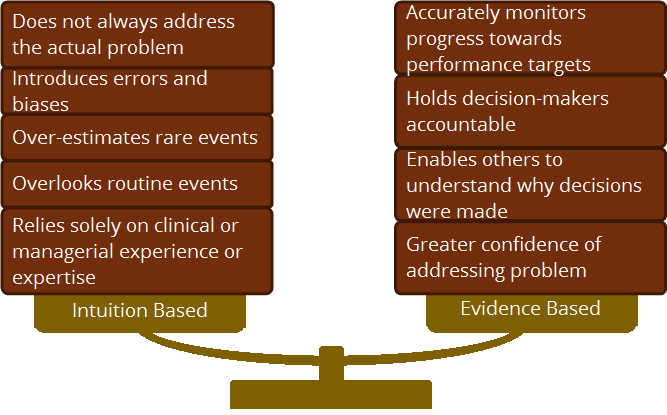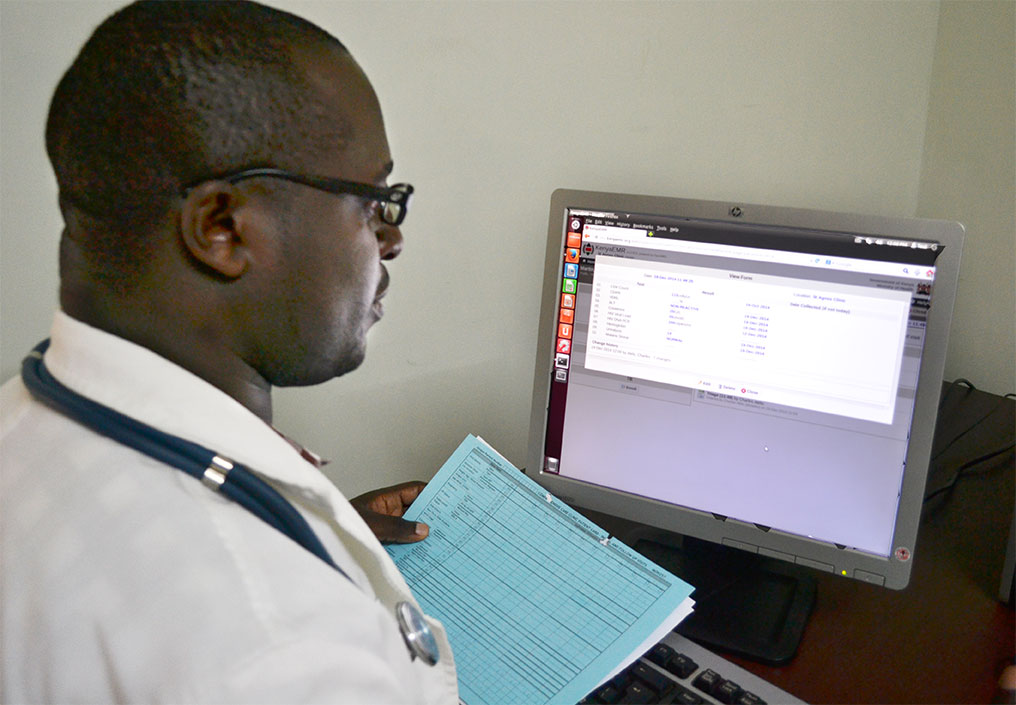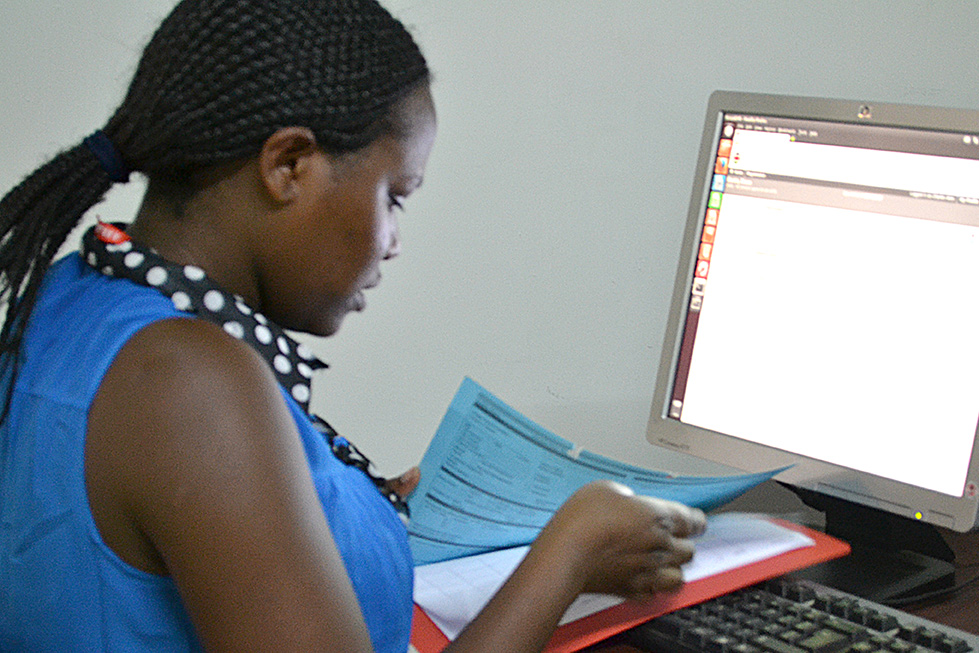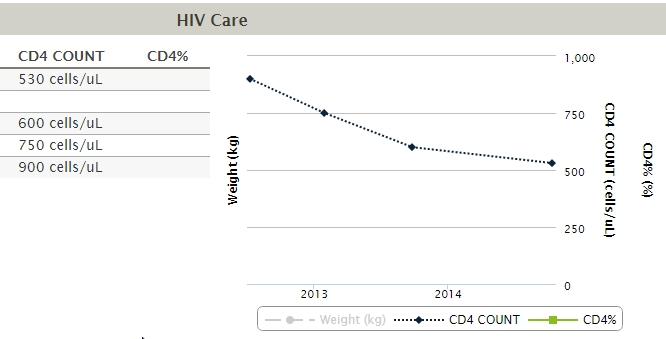Module 3: Using EMR Data for Decision Making
Welcome to this module on Using EMR Data for Decision Making. The purpose of this module is to make quality data available and easily accessible to those making a variety of decisions. How can an EMR system make it easier for you to use data to make stronger decisions about patient care, program or resource management, or policy? Read the learning objectives to discover what you will learn in this module.
Learning Objectives
After taking this module, you’ll be able to:
- Describe the process of transforming data into information used for decision-making
- Explain the importance of evidence-based decision making to improve service delivery
- Explain how an EMR system supports evidence-based decision making
- Identify KenyaEMR reports that can inform specific service delivery, resource management, and programmatic decision making
Learning Activities
-
Video: Using Data Is Easier With EMRs (5 min)
Welcome to this module on using EMR data for decision making. We will start this module with an example of using an EMR for decision making.
Instructions: Click or tap the video to play.
After you watch the video, click the button below the video to dissect the example.
-
Reading: Who Makes Decisions and Where? (5 min)
At all levels of the health system, decisions are made that impact the care and treatment that patients receive. Decisions made at the national and county level about policy, program design and direction, and resource management have facility level implications. Administrators and clinicians at facilities routinely make decisions about facility resources, activities, and clinical care and treatment.
Instructions: Click or tap the buttons to see examples of decisions made at each level and who makes them.
Decision makers: medical superintendent, facility-in-charge, clinicians
Clinical care
- Diagnoses
- Type of follow up
- Starting treatments
- Selecting appropriate treatments
- Changing treatment regimens due to side effects
- Viewing results from selected lab tests
Resource Management
- Equipment management
- Stock management
- Staff scheduling
- Vehicle scheduling
- Budgeting
Programmatic
- Community outreach activities
- Peer educator programs
- Mentoring programs
- Service availability
Decision makers: county health management teams, County Health Director
Clinical care
Adherence to guidelines among facilities within the county.
Resource Management
- Equipment management
- Stock management
- Staff hiring
- Posting and scheduling
- Vehicle scheduling
- Budgeting
Programmatic may include:
- Community outreach activities
- Peer educator programs
- Mentoring programs
- Service availability
Decision makers: MOH, NASCOP, NPHLS, WHO, PEPFAR, etc
Clinical care
Influences clinical practice at the facility level, resource assignment and management at the county and facility level.
Resource Management
- Commodity procurement
- Staff profiles
- Staff posting
- Budgeting
Programmatic
- Design, implementation, and scale up of program activities at the national level
- National level media campaigns, population-wide incentive programs, etc.
Policy
- Developing or updating standard treatment guidelines
- Essential medicines lists
- Dispensing protocols
- Standardizing or updating data collection tools
-
Reading: What Influences Decision Making? (10 min)
All of these decisions are influenced by different factors, ranging from actual data to hearsay. Evidence-based decision making occurs when decisions are informed by data, transparently and together with stakeholder or patient consultation. Some flags help clinicians identify patients who are ready to start an HIV regimen based on their CD4 count or WHO staging while others may indicate missed appointments or test results.
Decisions that are influenced by stories, powerful or influential connections, politics, or at random are examples of intuition-based decision making. This means that the process of making decisions is solely based on something that is known, perceived, understood, or believed by instinct, feelings, or nature - without actual evidence.
Instructions: Click or tap the buttons to learn more about intuition-based decision making.
Anecdotes
Stories or anecdotes about other patient’s experiences with various care or treatment options are used to inform decisions about a patient. For instance, if Dr. Ochieng heard from a fellow staff member that a particular patient had been rumored to have secretly sold ART drugs obtained at another facility, she may be reluctant to enroll this patient on treatment when there are so many others she can start on treatment.
Powerful & Influential Connections
Third parties who wield power and influence may use them or be perceived to use them to influence care and treatment decisions. If Dr. Ochieng knows that a patient’s brother is a well-known member of a group of merchants, this information may lead her to enroll the patient in the HIV program and set her up to start treatment in order to make a favorable impression on the brother.
Political
Personally held political views may introduce bias when a policy-maker, administrator, or clinician makes a decision. For example, if Dr. Ochieng learned that a patient is heavily involved in promoting a political agenda that goes against Dr. Ochieng’s political beliefs, she may pay less and less attention to this patient’s progress on treatment over time.
Arbitrariness
Decisions made on an ad-hoc basis, without consistency. Screening random patients for TB―whenever the provider remembers to do so and regardless of any clinical observations or information―is an example of an arbitrary decision.
-
Quiz: Evidence or Intuition? (10 min)
What does an evidence-based or intuition-based decision look like? Read 2 examples and decide if they are based on evidence or intuition.
Example 1:It seems that more women are coming to the clinic seeking ANC services. I suspect this is because few people know about family planning. I will talk to the community team about doing more outreach on family planning and the contraceptives available at the clinic for next month.
Example 2:From the monthly ANC report, it looks like 15 more women came in for ANC services this month. The stock status report indicates that we have not had a stock out of contraceptives in several months. I remember at our last meeting, the community team talked about an ANC promotional campaign that was piloted nearby in late September. Now that I look at the records of some of these new patients, it looks like they are coming from this area. This new campaign seems to be working! I’ll see what I can do to expand it to other areas.
-
Reading: Strengthening Decisions by Using Data (5 min)
Intuition based decision making tends to capture the social context in which decisions are made--and only calls on clinical or managerial experience and expertise. When made in the absence of data, this approach to decision making can lead to overlooking routine events, over-estimating rare ones, and introducing errors and biases. More importantly, the decision you make based on our instinct does not always address the actual problem.
Using data to inform decisions addresses many of these limitations. When you use data to make decisions, you have greater confidence that you are addressing the actual problem with a solution that is more likely to work. Additionally, evidence based decision making enables others to see and understand why decisions were made, holds decision-makers accountable, and accurately monitors progress towards performance targets.
-
Reading: Using EMR System Data to Make Decisions (5 min)
Using data for decision making relies on the availability of and access to data. EMR systems are powerful tools that make quality data easily accessible to those who want to use the data for decision making.
Unlike paper records that are stored in on and off site filing rooms, EMR systems make retrieving, organizing, and aggregating patient data relatively easy. Most EMR systems allow users to run reports, access or create graphs, or export data that can be further manipulated in a different program, such as Excel.
-
Activity: Scenario – Treating HIV Patients (15 min)
Let’s take a closer look at how EMR data can be used to make the different types of decisions that we were talking about earlier. You will work through 4 different decision areas, beginning with treating HIV patients.
Instructions: Click or tap the buttons below to work through the scenario. Please move left to right to successfully complete this activity.
Scenario
Dr. Ambrose Otieno is the CCC in-charge at Majimazuri Health Center. His goal for the upcoming quarter is to have 80% of eligible HIV patients started on treatment. In July, he uses KenyaEMR to prepare the monthly MOH711 report. In reviewing this report, Dr. Otieno notices that 25 patients started on ARVs this month. The same report tells him that 200 patients are eligible to be started on ARVs. He is aware that KenyaEMR usually raises a yellow alert or flag indicating when a patient is eligible for ART. What data will help Dr. Otieno decide how to increase the number of HIV patients on treatment?
Goal: 80% of eligible patients started on treatment
MOH711:- 25 patients started on ARVs this month
- 200 patients eligible for ARVs
Starting Eligible HIV Patients on Treatment
Now that you have an idea about the data that Dr. Otieno can use to increase the number of eligible patients on ART, what EMR reports will he need to generate in order to have that data?
Read about the data provided on each report.
- MOH711: National Integrated From for Reproductive Health, HIV/AIDS, Malaria, TB, and Child Nutrition. Contains aggregate data for any specified month.
- MOH731: NASCOP’s comprehensive HIV/AIDS facility reporting form, containing aggregate data for any specified month.
- Patients with declining CD4: Total number of patients, male and female who have declining CD4 counts, hyperlinked patient name, age, sex, Unique Patient Number, previous CD4 count and current CD4 count.
- Patients with known HIV status at enrollment: Total number of patients, male and female, whose HIV status is known at enrollment in MCH program, hyperlinked patient name, age, and sex.
- Patients who are lost to follow up: Total number of patients, male and female, who are lost to follow up, hyperlinked patient name, age, sex, and Unique Patient Number.
- Patient dashboard: A banner at the top of each patient’s medical record where core patient data is displayed (age, date of birth, sex, patient/registration numbers, etc.) as well as their visit status (out-patient, current, etc.). Based on specific criteria, different yellow alerts will be displayed here as well. These alerts include: Due for CD4, Missing TB Sputum Results, Eligible for ART, On ART, etc.
- Patients eligible for ART: Total number of patients, male and female who are eligible for ART, hyperlinked patient name, age, sex, and Unique Patient Number.
Starting Eligible HIV Patients on Treatment
Question: What reports can Dr. Otieno use to help him meet his goal?
Instructions: Click or tap each option to find out which reports help Dr. Otieno to reach his goal.
Did Dr. Otieno use the right reports to inform these decisions?
These reports are excellent choices―when used together!
Using the data from these three reports as well as the Eligible for ART alerts allowed Dr. Otieno to make decisions about who to target and how. He also used these reports and the MOH711 to monitor progress towards his goal of starting 80% of eligible patients on treatment.
-
Activity: Scenario – Improving MCH Patient Care (15 min)
You are doing a great job so far! Let’s look at another scenario on how EMR data can be used to make the different types of decisions that we were talking about earlier.
ScenarioDr. Susan Nkirote, the MCH in-charge at Kolol Health Centre, hopes to better integrate PMTCT services into the care and treatment she gives HIV positive MCH patients. She decides to look more closely at her patients’ KenyaEMR Charts during their follow up visits and use data from their charts to determine when PMTCT services can be initiated. At Mary Nzioka’s visit, Dr. Nkirote calls up Mary’s chart.
Instructions: Click or tap on all of the data displayed on Mary Nzioka’s chart that Dr. Nkirote can use to guide her decisions.
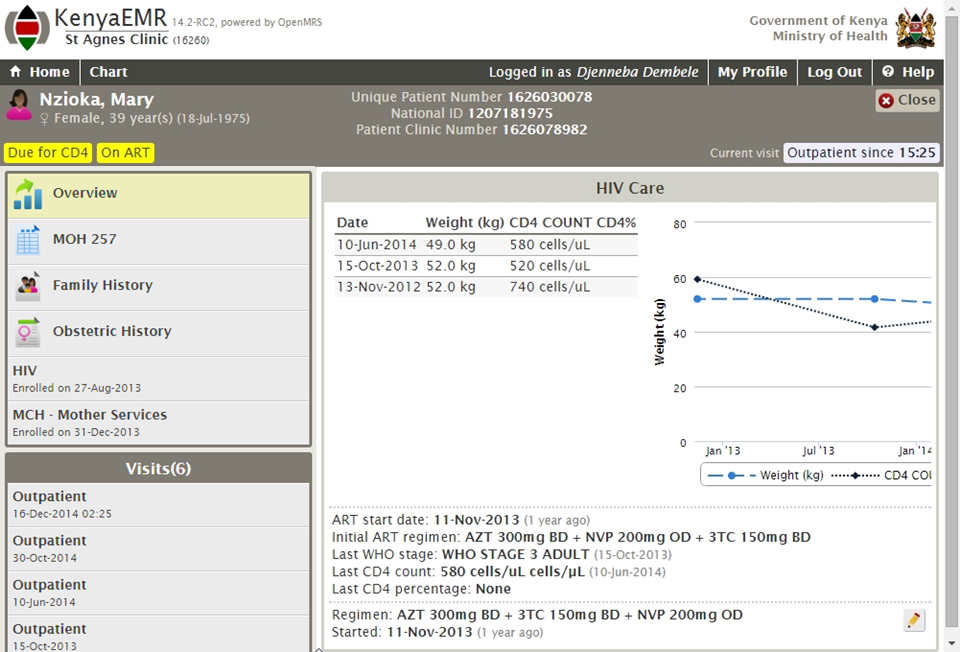
On ART
Yes! This data tells us that Mary is following an ART regimen.
Family History
Yes! This data tells us that Mary and her spouse are discordant couples. Dr. Nkirote can also see that three of Mary’s family members do not know their HIV status.
HIV
Yes! This data tells us that Mary is currently enrolled in the HIV program.
MCH Mother Services
Yes! This data tells us that Mary is currently enrolled in the MCH program.
ART start date
Yes! This data tells us when Mary started ARV treatment and the regimens that she has followed.
Try again
Please try another spot on the form.
-
Activity: Scenario – Strengthening Integration of Family Planning and Prevention With Positives (15 min)
Next, you will complete a third case scenario that focuses on strengthening integration of family planning and prevention with positives. Begin by reading the following scenarios and then responding to a couple questions.
Instructions: Click or tap the buttons below to work through the scenario. Please move left to right to successfully complete this activity.
Scenario – Part 1
Latum Mission Hospital wants to make sure that the right patients receive consistent messages about family planning and prevention with positives.
Question: What three pieces of data can Latum Mission Hospital’s health care workers use to strengthen integration of family planning and prevention with positives?
Instructions: Click or tap on 3 of the choices and see how the data is used to make a decision, then click the Feedback button.
Scenario – Part 2
Health care workers at Latum Mission Hospital decided to use data on the number of patients using contraceptives, the number of patients given condoms, and the names of MCH patients who are HIV positive.
Question: What reports should Latum Mission Hospital’s health care workers use to strengthen integration of family planning and prevention with positives?
-
Activity: Scenario – Improving National TB Policies (15 min)
Keep up the great work. Let’s complete one more case scenario focused on improving National TB Policies.
Instructions: Click or tap the buttons below to work through the scenario. Please move left to right to successfully complete this activity.
Scenario
The National Care and Treatment Technical Working Group is holding their quarterly meeting this month. Their agenda includes an examination of co-infection trends and discussion of recommended policy changes.
Reports
The Technical Working Group has decided to review data from the last six months on the total number of- HIV patients testing positive for TB
- TB patients with a positive HIV test result
- HIV patients screened for TB
Question: What reports should they use to inform their discussion?
Instructions: Click or tap each report to reveal additional information.
-
Reading: How We Use Data When Making Decisions (5 min)
As you have seen from the different decisions made by Dr. Otieno, Dr. Nkirote, health care workers at Latum Mission Hospital, and the National Care and Treatment Technical Working Group, data plays an essential role in making evidence based decisions. Data helped each of these decision makers as they engaged in a process of identifying a problem, determining possible solutions, and selecting the best way forward. Quality data, when available, improves our ability to make effective decisions.
Instructions: Click or tap each step in the decision making process to see how and when data can help make strong decisions.
Identify the problem
Use data to understand what the problem actually is, who is involved, and where and when it occurs.
Determine possible courses of action
Use data to identify different outcomes of possible solutions.
How has this problem been resolved in the past?
Decide on a single course of action
Data can be used to assess the different possible outcomes or what the solution would require.
Implement a single course of action
Depending on the solution you arrive at, seeking out additional data may be a part of putting your decision into place.
Monitor and evaluate the outcome
Subsequent data on the problem can indicate whether the solution you implemented has been successful.
-
Reading: Making Data Useful (5 min)
Let’s take a closer look at what happens to data during this process. In each decision-making scenario, the decision makers started with raw data and turned it into useful information. A single piece of data, for instance, a CD4 count of 600, is more useful when we compare it with other data, such ranges for laboratory test results or clinical observations. As soon as we have data that we can compare, data becomes information that we can analyze and use to make decisions.
-
Reading: The Process (5 min)
Instructions: Click or tap each stage in the diagram to find out more about this process.

Data
Simple measures of characteristics of people and things has little inherent meaning or value on its own. Knowing that 15 ANC visits occurred this month is not useful for decision making―until other data or information is available.
Information
Data that are processed to be useful provides answers to “who,” “what,” “where,” and “when” questions. Knowing that 4 out of the 15 ANC visits were made by patients testing positive for HIV makes this data more valuable for decision making.
Knowledge
Application of data and information. Clinicians and facility-in-charges can make clinical or programmatic decisions that can lead to enrollment of HIV+ ANC clients in PMTCT services or starting a patient on prophylaxis.
-
Reading: Summary (5 min)
You’ve just learned about how evidence-based decision making improves service delivery by pinpointing issues and developing targeted responses.
You also learned how to turn data into useful information by comparing a single piece of data with other data, making it analyzable information. Through the examples provided, you now know how an EMR system can generate reports that clinicians, policy-makers, and managers use to support evidence-based decision making.
Remember, MOH reports can be useful in identifying trends that inform policy decisions or monitor progress towards goals. HIV, MCH, or TB reports can provide more specific data about patients that clinicians and facility managers will find particularly useful in informing service delivery and resource management. Now go on to the final quiz.
